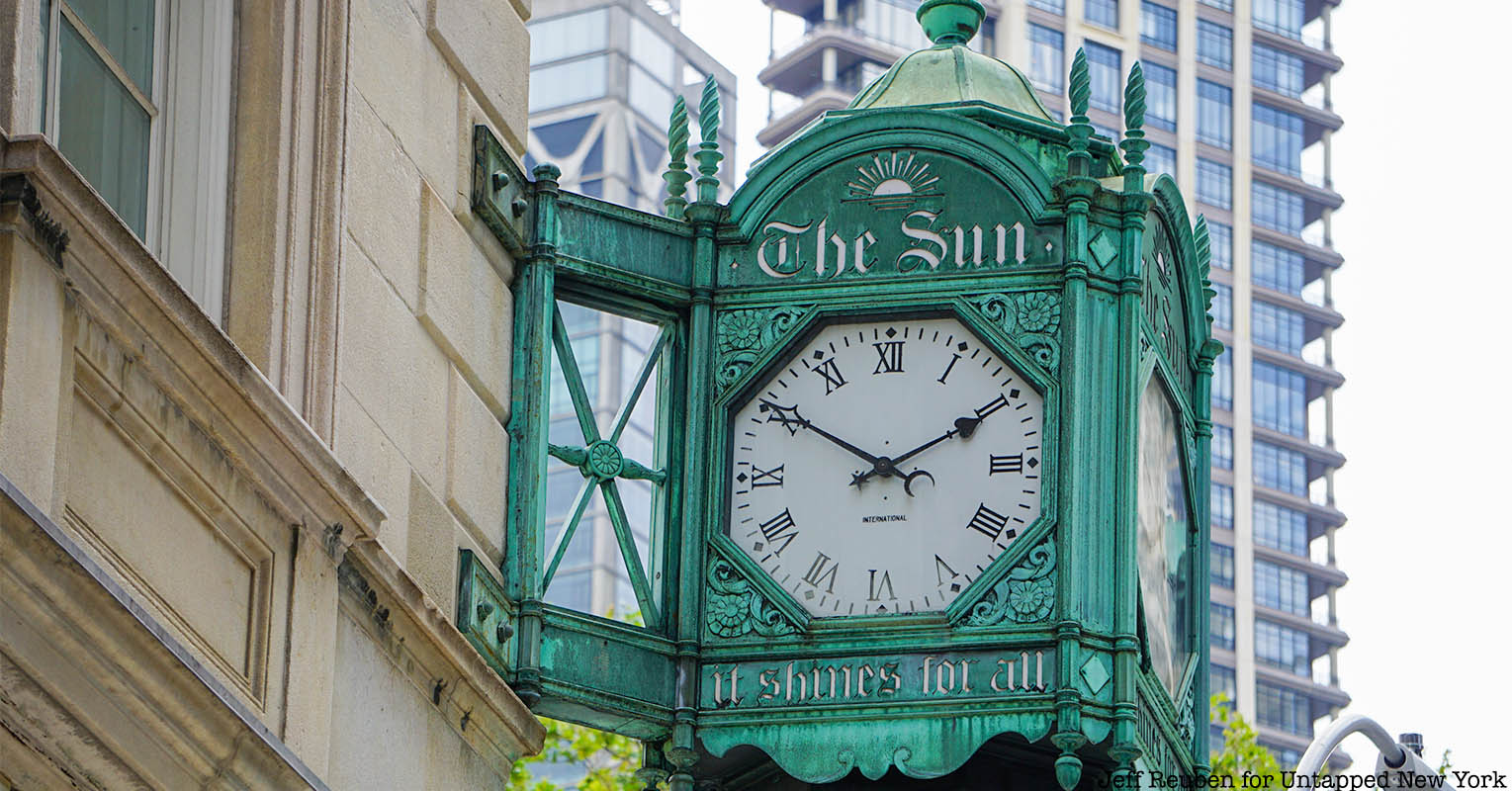Since the 1930s, the Sun Clock and Thermometer at 280 Broadway in Lower Manhattan have reported the time and temperature, albeit not always correctly. However, thanks to a recently completed restoration project they once again “shine for all”. But their own story has remained clouded by the fog of lost history and we thought it was time to shed a little light on these beautiful relics.
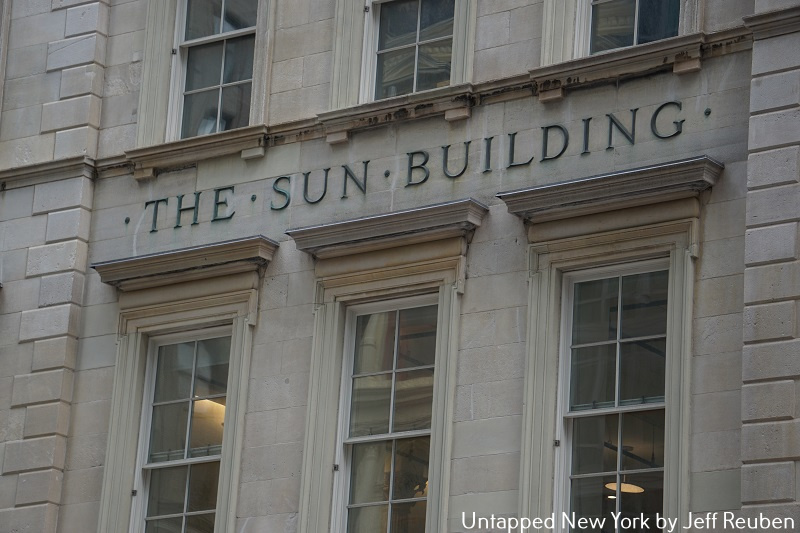
The building at 280 Broadway was constructed by A.T. Stewart in the 1840s as New York’s first department store and subsequently was home to the New York Sun newspaper from 1919 to 1950. Still known as The Sun Building, its current primary occupant is the New York City Department of Buildings.
New York City’s landmark designation report and the National Register nomination form for the building offer no substantive details about the clock and thermometer, apart from the obvious: that they were installed by The Sun. Although the trail went cold on the official history front, a clue to the clock’s origins is hiding in plain sight.
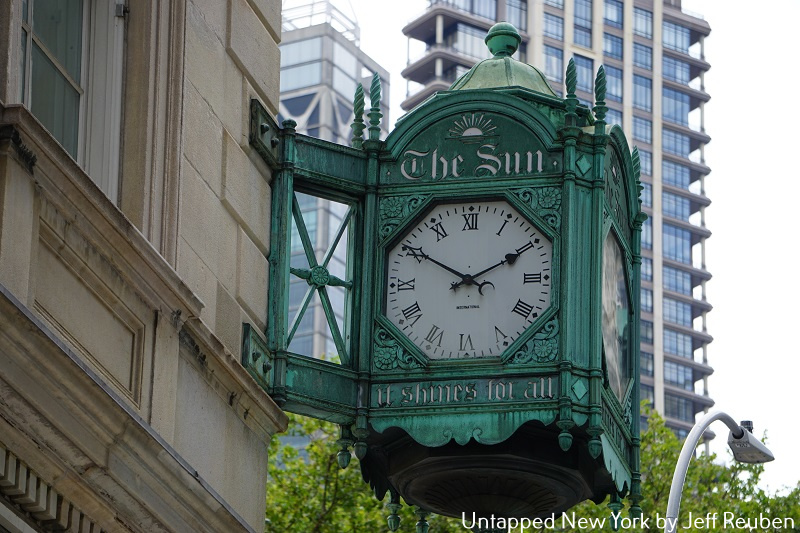
It is mounted on the edifice’s southwest corner and contains four faces, or dials as they are called in the timekeeping trade. The west and north dials bear the word “International” in an all-caps sans-serif font. A dive into clock history revealed that this was a logo used by International Time Recording (ITR). Although originally an independent firm, by the time The Sun moved to this location ITR was a division of International Business Machines, better known today as technology giant IBM.
To learn more, I reached out to Dave Dietrich of International Time Machines in Stamford, Connecticut, who restores historic clocks. He told me that although ITR’s stock-in-trade consisted of time and wall clocks for commercial, industrial, and institutional clients, it provided a wide range of customized products including some of this type.
Dietrich did some digging and found The Sun Clock’s Holy Grail: a 1930 article from an IBM in-house publication stating that The Sun officially unveiled the clock on July 12 of that year. The piece quotes extensively from that day’s edition of The Sun. This appears to be the only surviving contemporary source; online and microfilm New York Sun archives are missing that particular issue.
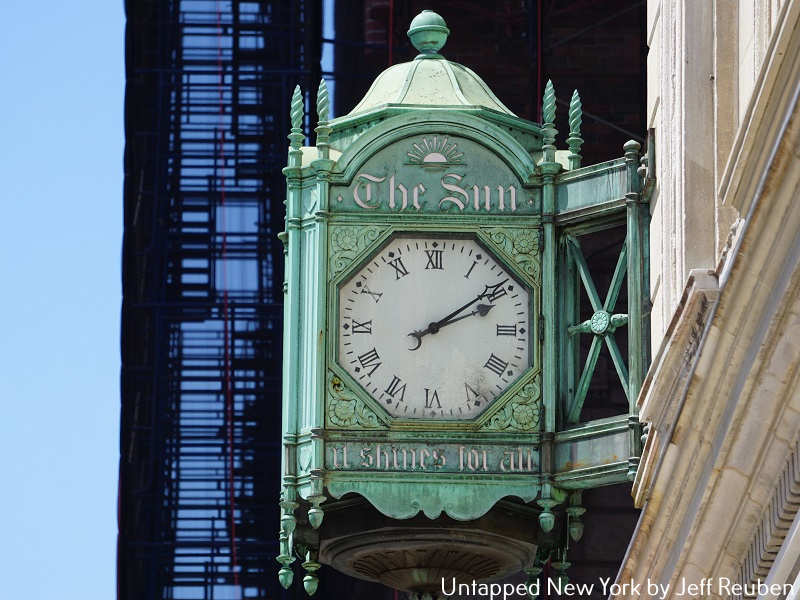
As repeated in the IBM publication, the Sun of July 12, 1930 touted its new horological gem as “a period clock, planned in the classic spirit” but also detailed its modern mechanics that advanced the “graceful and easily discernible” hands by electric pulse.
To be sure, the coverage was self-congratulatory and hyperbolic, but the clock’s artistry is undeniable. For example, the hour hand has a heart-shape pointer with a star at its tail and the minute hand a diamond-shaped pointer and crescent at its end. For historical context I turned to Dietrich, who describes these as “highly unique” for ITR. He says that although ITR often produced clock hands, in this case they may have been fabricated by another company.
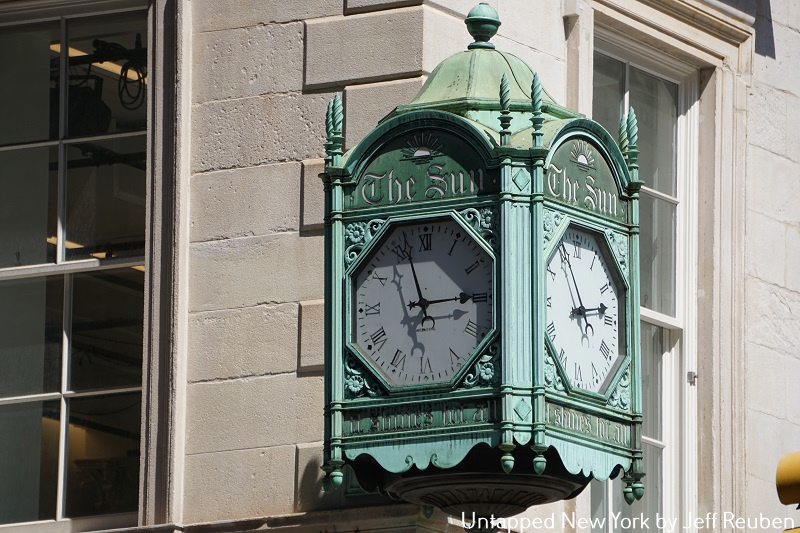
Getting back to the 1930 article, it reported that the clock dials were placed within a “bronze case four feet square and eight feet high. This weighs 1,500 pounds” and credit for it was shared by its designer, Gerald A. Holmes, an architect whose work included the Tammany Hall building, and its fabricator, Jno. Williams, Inc., a prominent foundry responsible for Columbia University’s Alma Mater statue.
Above the octagonal dials the bronze case displays The Sun’s logo, with its name in a Gothic font and a sunburst; the paper’s motto, “It Shines for All’ is below. It is also ornamented with decorations, finials, and a domed top. The clock was placed at the busy crossroads of Broadway and Chambers Street and across the street from City Hall Park. Among those seeing it daily were IBM executives, whose general offices were located diagonally across the street at 270 Broadway.
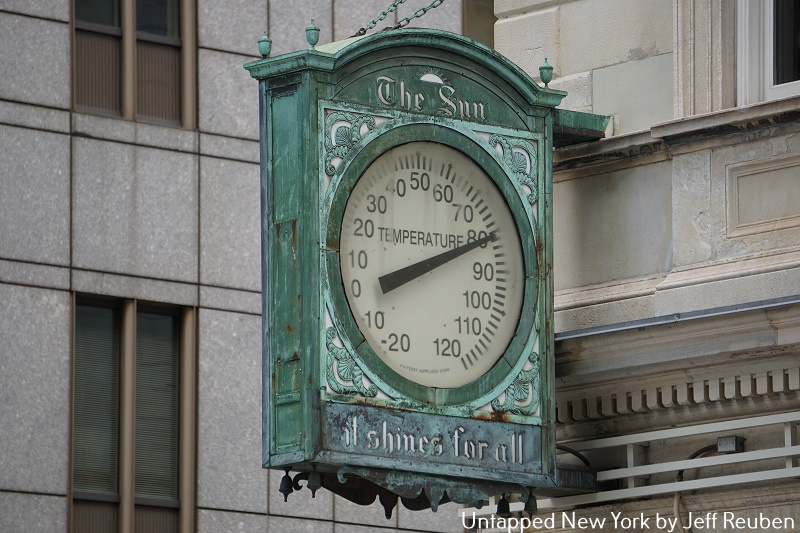
The Sun added a two-sided thermometer with analog faces to the building’s northwest corner on December 21, 1936, the Winter Solstice. Unlike the clock, an article about the thermometer’s debut is available online.. The paper reported that the thermometer faces were three feet, nine inches in diameter with a hand three feet, two inches long pointing to temperature numbers in degrees Fahrenheit. Similar to the clock, the faces rest inside a bronze casing with the paper’s logo, motto and decorative details. All together it weighed about 1,000 pounds. The casing was created by United States Bronze Sign Company, a firm that still exists. Among many other projects it created the Monument Park plaques for Yankee Stadium.
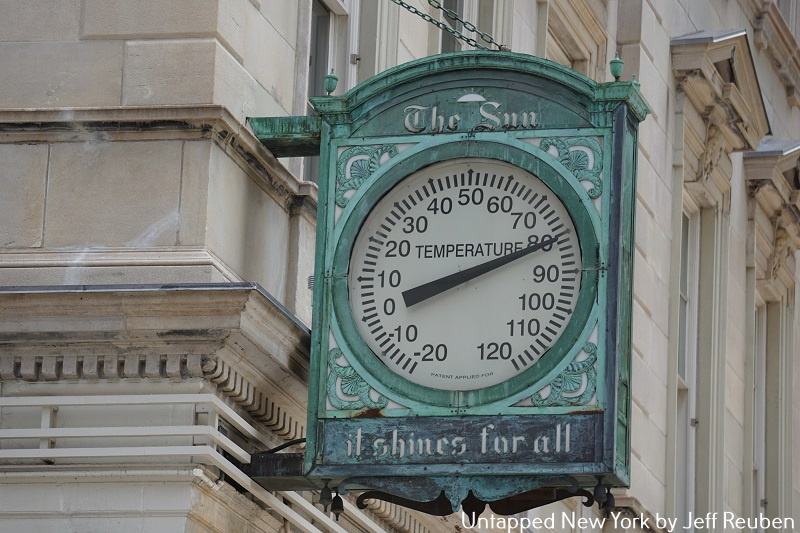
Taylor Instrument Companies of Rochester, NY manufactured the thermometer and a photograph published by the paper shows the word “Taylor” in a cursive script on the face, evidence that the current faces are not original. As shown in the image above, they display the words “patent applied for” in place of the company’s name, but in other respects closely resemble the original. Taylor Instrument today is part of multinational conglomerate ABB.
A possible explanation for the replacement or alteration of the original faces is provided by a 1943 Sun article which reported that “after years of exposing its face to the elements,” the thermometer’s south side “started to peel.” In response a new enamel facing was applied. The face was also removed in the most recent restoration in 2020.
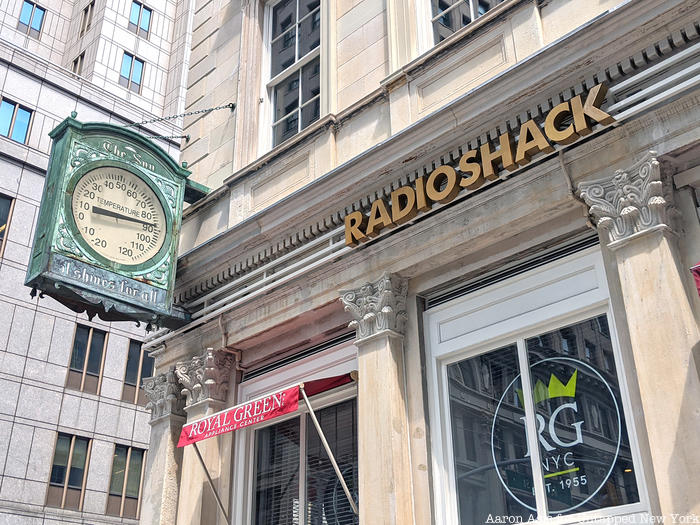
More existential threats loomed on the horizon. The Sun closed in 1950 and a year later the building was sold to a new owner who intended to replace it with a high rise building. Those plans fell through and as the Long Island Star-Journal observed in 1959, “the huge New York Sun clock, labeled ‘it shines for all,’ is still hanging forlornly.” Things looked even bleaker when the City acquired the site in 1966 as part of plans to replace The Sun Building with a civic center skyscraper. By that point, the Sun Clock and Thermometer were no longer working.
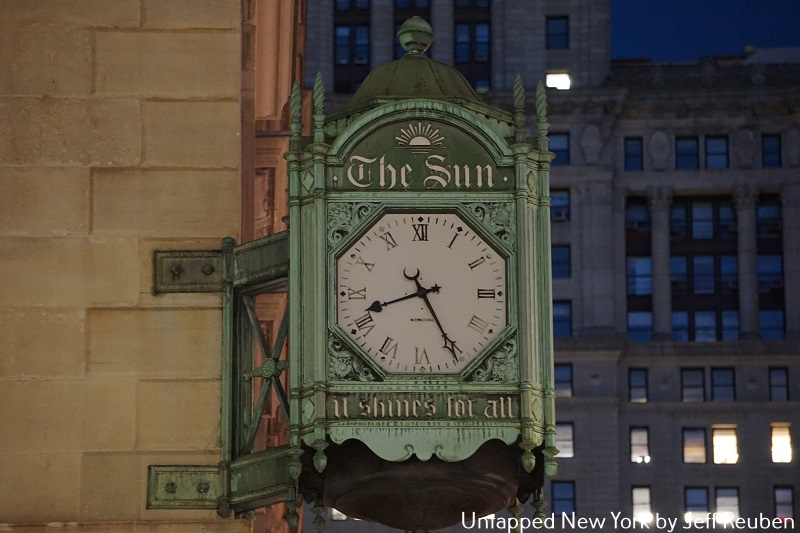
But, out of darkness, came a new dawn. In an era marked by the loss of the original Penn Station, activist Margot Gayle and others formed The Friends of the Old Sun Clock, raised funds, and convinced the City to repair the clock. In 1967 the restored clock was rededicated. Two of the dials had to be replaced, the New York Times reported, which may explain why those on the south and east are missing the word “International.” Meanwhile, a sign appeared on the Sun Thermometer reading: “Please somebody, fix me too.” However, a 1981 Times article noted that the clock worked but the thermometer did not, which was also the case in the late 2000s.
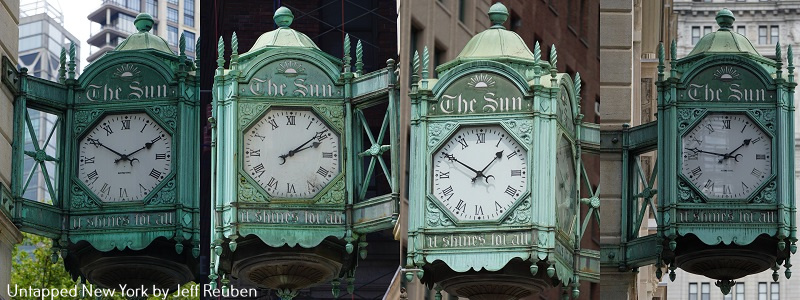
The City eventually dropped its demolition plans and landmarked the building in 1986. The clock stopped ticking the following year but was fixed in 1988, with another push from Friends of the Old Sun Clock. In fact, that group remained active for years as a guardian for various public timepieces.
Fast forwarding to our times, in 2020 the City completed a major facade restoration of the Sun Building. The New York Landmarks Conservancy gave the project a Lucy G. Moses Preservation Award, noting that “the finishing touch was refurbishment of the historic Sun clock and thermometer.” The project team included the City’s Department of Design and Construction and Department of Citywide Administrative Services, Urbahn Architects, Jablonski Building Conservation, Jacobs Engineering, and Lo Sardo General Contractors.
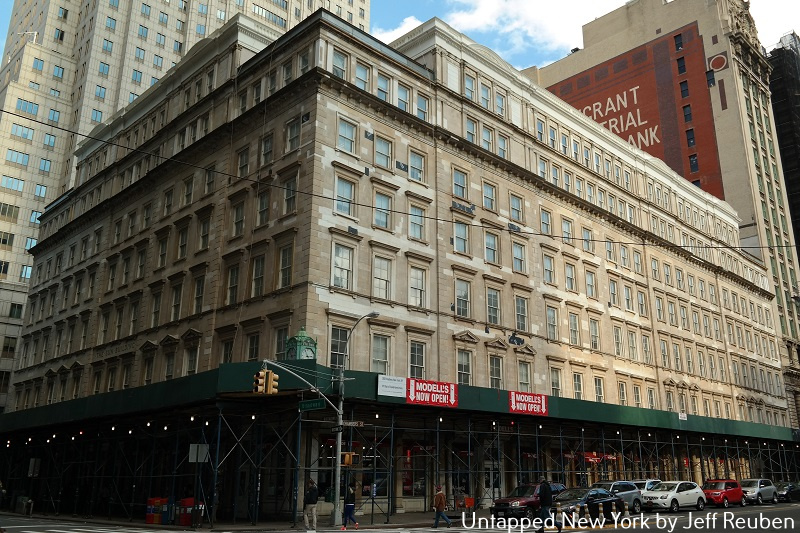
After being covered by sidewalk sheds and scaffolding for over a decade (see photo above), the clock and thermometer are once again working and can be viewed unobstructed in all their glory. (see photo below).
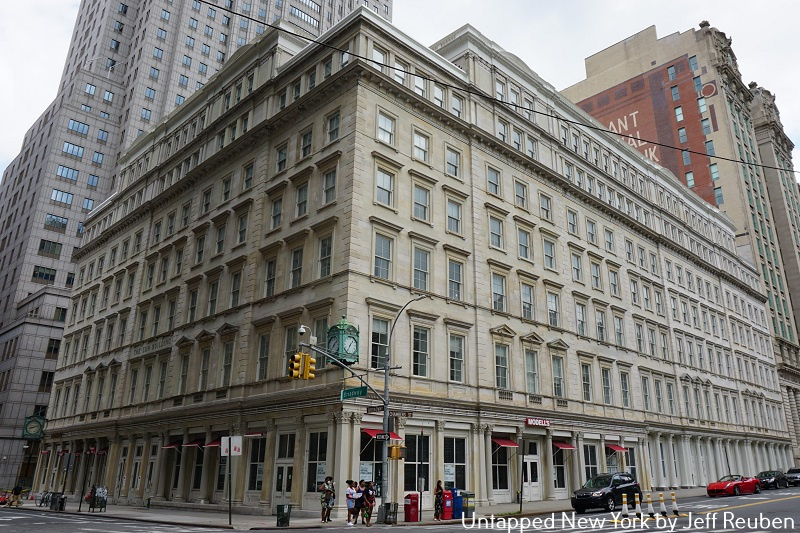
Next, check out other Ghosts of Newspapers Past. Contact the author at Jeff Reuben.






